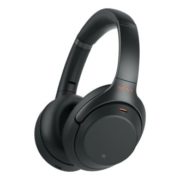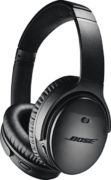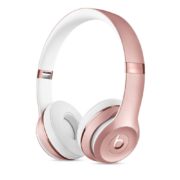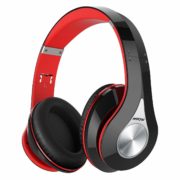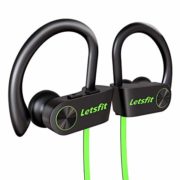List of the Best Wireless Headphones
1. Sony Noise Cancelling Wireless Headphones
Pros
Cons
Bottom Line
The Sony Noise Cancelling Wireless Headset makes a bold attempt to create a wireless headset that integrates both technology and quality into one product. However, it was also a risk to release it without having carefully refined it. The design flaws showed through its errors, which all could have been avoided if they had just taken the time to revise their features and controls.
For those who never experience any of the mistakes mentioned above, the Sony Noise Cancelling Wireless Headset is highly capable of being a perfectly functional gadget. It can provide hours of usage, crisp HiRes audio, advanced features, and a premium quality wireless experience. At it's best, the Sony Noise Cancelling Wireless Headset can be worth every penny it costs.
Read our in-depth Sony Noise Cancelling Wireless Headphones Review here.
2. Bose Wireless 35
Product Highlights
- Excellent sound quality for the price it comes with
- Has many features to offer
Pros
Cons
Bottom Line
To summarize, the Bose QuietComfort 35 wireless headphones II can deliver reliable performance and fantastic clarity along with advanced features that make listening to music convenient and comfortable. But due to drawbacks from a significant part of its purpose — to provide seamless Bluetooth connectivity — it isn't able to clutch on to the title of best wireless headphones this year.
It is, however, among the top contenders, thanks to its exclusive Bose AR via the Bose Connect app. Aside from this excellent addition, it also boasts the best sound quality and versatile features that make it such a pleasure to listen to while playing, working, or jamming tunes. Overall, the Bose QuietComfort 35 wireless headphones II is an excellent option for anyone who wants to get their hands on some premium quality wireless headsets.
Read our in-depth Bose Wireless 35 Review here.
3. Beats Solo3 Open Ear Wireless Headphones
Product Highlights
- Delivers excellent quality, HiRes audio
- Provides up to 40 hours of battery life, for endless music
Pros
Cons
Bottom Line
The Beats Solo3 Wireless Headphone should've been a cut above the rest, but fails to do so because of its lack of quality. What was once the headphone dream of every university student, now seems to be a dreaded nightmare to some. But even with its troubled technical aspects, it remains to be one of the most popular and best-selling headphones this year.
Despite its shortcomings, it makes up for it in its amazing features and aesthetics and proves to retain the award-winning characteristics of the models before it had. If you don't mind shelling out some money for a decent pair of headphones that can deliver excellent sound and clarity while providing you with a beautifully designed compact body, then the Beats Solo3 Wireless is for you.
Read our in-depth Beats Solo3 Open Ear Wireless Headphones Review here.
4. Mpow wireless headphones
Product Highlights
- Most affordable wireless headphones out in the market now
Pros
Cons
Bottom Line
While it starts with exceptional performance, the Mpow 059 Bluetooth Headphone isn't able to hide its flaws, especially with extended use. Under its seemingly perfect design, the cracks start to show only after a few months and can start going downhill from there. However, for its small price of $35 compared to other models, it is one of the best headphones within its price range.
If you get a good pair of these and never encounter the problems mentioned above, then you have scored yourself one of the most versatile and lightweight headphones that you can rely on for your workouts, running, hiking, and outdoor activities. And with its excellent features, you are sure to enjoy this product without the need to shell out big sums of money. In the end, the Mpow 059 Bluetooth Headphone is worth the small cost it asks for.
Read our in-depth Mpow wireless headphones Review here.
5. LetsFit Active Wireless Headphones
Product Highlights
- Can offer excellent features at a small cost
- Has noise-canceling features technology for ease of communication
- Its 8-hour battery life is perfect for all your outdoor activities
Pros
Cons
Bottom Line
The LetsFit Active Headphones start well upon purchase and can even be a serious contender for being the best wireless headphones available in the market — that is if it continues to function the way it should. But this model has some significant gaps in its performance throughout its use, which goes from working perfectly well, to being barely usable. Issues that are this significant have a negative impact on its users and in their daily activities.
Because the manufacturers overlooked these factors, they have no doubt lost the opportunity to deliver an excellent headset. However, at its price range, the LetsFit Active Headphones are still one of the best and most affordable headphones out now. For $20, you can have a lightweight and functional wireless headphones that have innovative features, excellent sound quality, and waterproof capabilities. All in all, if it works well for a few months, spending that money isn't so bad.
Read our in-depth LetsFit Active Wireless Headphones Review here.
